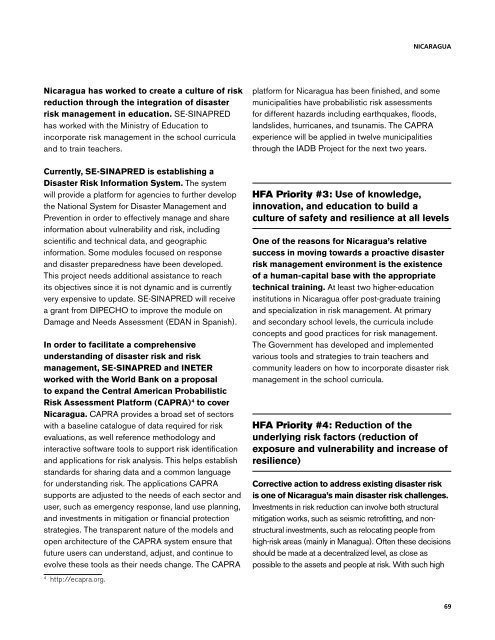Disaster Risk Management in Central America: GFDRR Country Notes
Disaster Risk Management in Central America: GFDRR Country Notes
Disaster Risk Management in Central America: GFDRR Country Notes
You also want an ePaper? Increase the reach of your titles
YUMPU automatically turns print PDFs into web optimized ePapers that Google loves.
nicaragua<br />
Nicaragua has worked to create a culture of risk<br />
reduction through the <strong>in</strong>tegration of disaster<br />
risk management <strong>in</strong> education. SE-SINAPRED<br />
has worked with the M<strong>in</strong>istry of Education to<br />
<strong>in</strong>corporate risk management <strong>in</strong> the school curricula<br />
and to tra<strong>in</strong> teachers.<br />
Currently, SE-SINAPRED is establish<strong>in</strong>g a<br />
<strong>Disaster</strong> <strong>Risk</strong> Information System. The system<br />
will provide a platform for agencies to further develop<br />
the National System for <strong>Disaster</strong> <strong>Management</strong> and<br />
Prevention <strong>in</strong> order to effectively manage and share<br />
<strong>in</strong>formation about vulnerability and risk, <strong>in</strong>clud<strong>in</strong>g<br />
scientific and technical data, and geographic<br />
<strong>in</strong>formation. Some modules focused on response<br />
and disaster preparedness have been developed.<br />
This project needs additional assistance to reach<br />
its objectives s<strong>in</strong>ce it is not dynamic and is currently<br />
very expensive to update. SE-SINAPRED will receive<br />
a grant from DIPECHO to improve the module on<br />
Damage and Needs Assessment (EDAN <strong>in</strong> Spanish).<br />
In order to facilitate a comprehensive<br />
understand<strong>in</strong>g of disaster risk and risk<br />
management, SE-SINAPRED and INETER<br />
worked with the World Bank on a proposal<br />
to expand the <strong>Central</strong> <strong>America</strong>n Probabilistic<br />
<strong>Risk</strong> Assessment Platform (CAPRA) 4 to cover<br />
Nicaragua. CAPRA provides a broad set of sectors<br />
with a basel<strong>in</strong>e catalogue of data required for risk<br />
evaluations, as well reference methodology and<br />
<strong>in</strong>teractive software tools to support risk identification<br />
and applications for risk analysis. This helps establish<br />
standards for shar<strong>in</strong>g data and a common language<br />
for understand<strong>in</strong>g risk. The applications CAPRA<br />
supports are adjusted to the needs of each sector and<br />
user, such as emergency response, land use plann<strong>in</strong>g,<br />
and <strong>in</strong>vestments <strong>in</strong> mitigation or f<strong>in</strong>ancial protection<br />
strategies. The transparent nature of the models and<br />
open architecture of the CAPRA system ensure that<br />
future users can understand, adjust, and cont<strong>in</strong>ue to<br />
evolve these tools as their needs change. The CAPRA<br />
4<br />
http://ecapra.org.<br />
platform for Nicaragua has been f<strong>in</strong>ished, and some<br />
municipalities have probabilistic risk assessments<br />
for different hazards <strong>in</strong>clud<strong>in</strong>g earthquakes, floods,<br />
landslides, hurricanes, and tsunamis. The CAPRA<br />
experience will be applied <strong>in</strong> twelve municipalities<br />
through the IADB Project for the next two years.<br />
HFA Priority #3: Use of knowledge,<br />
<strong>in</strong>novation, and education to build a<br />
culture of safety and resilience at all levels<br />
One of the reasons for Nicaragua’s relative<br />
success <strong>in</strong> mov<strong>in</strong>g towards a proactive disaster<br />
risk management environment is the existence<br />
of a human-capital base with the appropriate<br />
technical tra<strong>in</strong><strong>in</strong>g. At least two higher-education<br />
<strong>in</strong>stitutions <strong>in</strong> Nicaragua offer post-graduate tra<strong>in</strong><strong>in</strong>g<br />
and specialization <strong>in</strong> risk management. At primary<br />
and secondary school levels, the curricula <strong>in</strong>clude<br />
concepts and good practices for risk management.<br />
The Government has developed and implemented<br />
various tools and strategies to tra<strong>in</strong> teachers and<br />
community leaders on how to <strong>in</strong>corporate disaster risk<br />
management <strong>in</strong> the school curricula.<br />
HFA Priority #4: Reduction of the<br />
underly<strong>in</strong>g risk factors (reduction of<br />
exposure and vulnerability and <strong>in</strong>crease of<br />
resilience)<br />
Corrective action to address exist<strong>in</strong>g disaster risk<br />
is one of Nicaragua’s ma<strong>in</strong> disaster risk challenges.<br />
Investments <strong>in</strong> risk reduction can <strong>in</strong>volve both structural<br />
mitigation works, such as seismic retrofitt<strong>in</strong>g, and nonstructural<br />
<strong>in</strong>vestments, such as relocat<strong>in</strong>g people from<br />
high-risk areas (ma<strong>in</strong>ly <strong>in</strong> Managua). Often these decisions<br />
should be made at a decentralized level, as close as<br />
possible to the assets and people at risk. With such high<br />
69
















